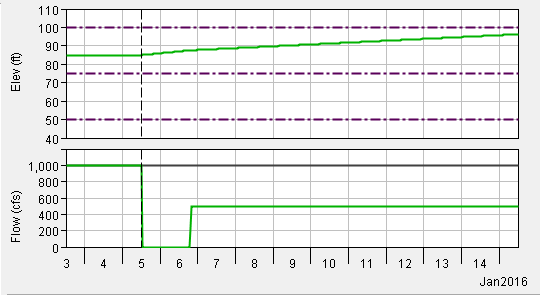This post further demonstrates the rule logic and rule behavior in HEC-ResSim.
The network below contains two reservoirs, one on the main stem and one on a tributary. There is 1,000 cfs entering the main stem and 1,000 cfs entering the tributary.

The tributary reservoir has no rules of operation. Basically, this means that the only constraint placed on that reservoir is the physical capacity of 5,000 cfs.

The reservoir on the main stem has a downstream control function that wants to limit the flow at the downstream junction, "downstream control point", to 2,200 cfs. Note that with no restrictions on the tributary reservoir, trying to keep the flow at or below 2,200 cfs falls solely on the main stem reservoir.

The tributary reservoir operations are shown below. The simulation begins with the reservoir in the flood pool. Since ResSim wants to release as much as possible and with the tributary reservoir having no restrictions, it releases its full physical capacity of 5,000 cfs (once the lookback period ends) until the pool is empty. It then passes the inflow of 1,000 cfs to hold top of conservation.

The main stem reservoir operations are shown below. Since the downstream control function is being violated, the main stem reservoir releases zero (after the lookback period) until the tributary reservoir is empty. At that point, the tributary reservoir is releasing the inflow of 1,000 cfs leaving 1,200 cfs capacity for the main stem reservoir. Note that I am using null routing in this model.

I also wanted to use this example to further explain when rule priority applies. For the next simulation, I add a maximum release rule of 500 cfs below the downstream control function rule. Basically, I now have two maximum release rules. The rule set is shown below.

The result of this simulation is shown below.

The release still goes to zero until the tributary reservoir is empty, however, now the release only increases to 500 cfs instead of 1,200 cfs. The reason for this is the ResSim uses the lowest maximum regardless of the order in the rule set. So, even though "ds rule" is at a higher position in the rule set, "max rel from main" still governs.
For minimum release rules, ResSim will use the highest minimum in the rule set. Rule priority, or the location of the rule in the rule set, factors in when there is a mix of minimum and maximum rules.
The network below contains two reservoirs, one on the main stem and one on a tributary. There is 1,000 cfs entering the main stem and 1,000 cfs entering the tributary.

The tributary reservoir has no rules of operation. Basically, this means that the only constraint placed on that reservoir is the physical capacity of 5,000 cfs.

The reservoir on the main stem has a downstream control function that wants to limit the flow at the downstream junction, "downstream control point", to 2,200 cfs. Note that with no restrictions on the tributary reservoir, trying to keep the flow at or below 2,200 cfs falls solely on the main stem reservoir.

The tributary reservoir operations are shown below. The simulation begins with the reservoir in the flood pool. Since ResSim wants to release as much as possible and with the tributary reservoir having no restrictions, it releases its full physical capacity of 5,000 cfs (once the lookback period ends) until the pool is empty. It then passes the inflow of 1,000 cfs to hold top of conservation.

The main stem reservoir operations are shown below. Since the downstream control function is being violated, the main stem reservoir releases zero (after the lookback period) until the tributary reservoir is empty. At that point, the tributary reservoir is releasing the inflow of 1,000 cfs leaving 1,200 cfs capacity for the main stem reservoir. Note that I am using null routing in this model.

I also wanted to use this example to further explain when rule priority applies. For the next simulation, I add a maximum release rule of 500 cfs below the downstream control function rule. Basically, I now have two maximum release rules. The rule set is shown below.

The result of this simulation is shown below.

The release still goes to zero until the tributary reservoir is empty, however, now the release only increases to 500 cfs instead of 1,200 cfs. The reason for this is the ResSim uses the lowest maximum regardless of the order in the rule set. So, even though "ds rule" is at a higher position in the rule set, "max rel from main" still governs.
For minimum release rules, ResSim will use the highest minimum in the rule set. Rule priority, or the location of the rule in the rule set, factors in when there is a mix of minimum and maximum rules.
I am trying to setup my system with HecRessim, I have two reservoirs in parallel meeting a common demand through diverted canals. The operating rules are to be setup as, one reservoir supply for the demand upto a fixed reservoir level and after meeting demands of first priority and if water is not sufficient to meet the demand fully then other reservoir supply water. I am not able to find as how this system can be setup in HecRessim. How this system where water can be diverted from two different canals to meet a common demand can be setup in watershed setup and then how to implement operating rules for this parallel reservoir system?
ReplyDeleteI have another query regarding release policy, suppose I have to release water to downstream for environmental flow then should I give environmental flow demand as time series in release function of external variable and use minimum limit for release rule for e-flow. Pl. reply ASAP
ReplyDelete